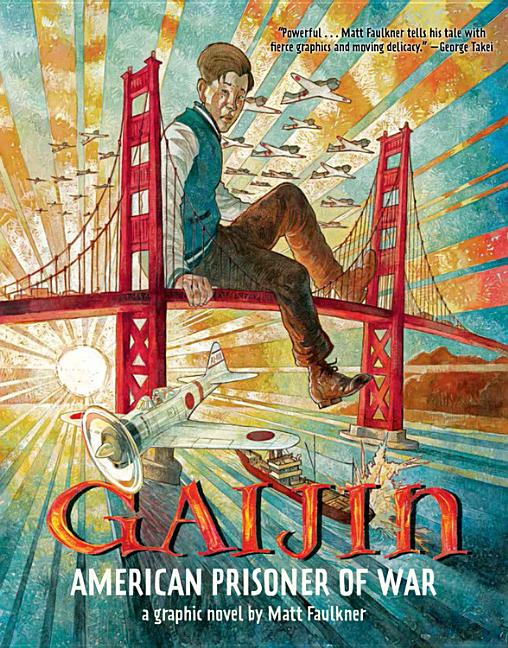Meet-the-Author Recording with Matt Faulkner
Gaijin: American Prisoner of War |
Matt Faulkner introduces and shares some of the backstory for creating Gaijin: American Prisoner of War.
Translate this transcript in the header View this transcript Dark mode on/off
Matt Faulkner: Hi there, this is Matt Faulker. I'm the author and illustrator of the graphic novel Gaijin: American Prisoner of War. I'm going to tell you a little bit about the book, how I came to make it, and then I'm going to talk about a double page spread that's in the book and talk about the materials and the subject matter that's on that particular spread.
When I was about ten or eleven years old, I read a whole bunch of books about the Holocaust in Europe during World War II. And one day my Mom came to me, and she said, "well you know, your Great Aunt Adeline and her daughter Mary were put in an American concentration camp".
And I said, "Mom that's not possible, there were no concentration camps in America." She told me there were, for people who were Japanese-American. My Aunt Adeline was Irish-American, but she'd married a Japanese man when she went to Japan in the 1920s. And that's the main reason why I decided to write this book, in honor of my Great Aunt Adeline, in addition to also wanting to help American children understand this particular sad part of our history.
So I'm going to talk about a page spread right now, that is about two-thirds of the way through the book. In the story the young man, Gaijin Miyamoto and his Mom, Adeline, have been placed in a fictional concentration camp called the Alameda Downs internment camp. This internment camp was based on the Tanforan internment camp, which was formerly a horse racing track. So Alameda Downs is a horse racing track, and people were put in horse stalls and made to live where the horses used to live.
This particular spread shows a dream sequence in which Gaijin is having a bad dream. He's crawled into a tool shed and he's fallen asleep after a gang, led by a guy named Joe, has been beating up on him. And in the dream we see Joe climbing up into a guard tower, and there's a couple of guards up there, and one of the guards is kissing Gaijin's mom. Now this is a bad dream remember, it didn't really happen, and the guard is yelling down to Joe the gang leader and he's saying: "hey Joe, come on up, Gaijin's mom is giving away kisses for free."
And Joe is saying: "yeah, I heard she's a real floozy." And what is also happening is a cable car, which is basically the subway system for San Francisco, is rushing past the guard tower and in the front of the cable car is Gaijin's dad. And so Gaijin runs after this cable car, trying to catch up with his dad in the dream. He just can't get there, it's just out of reach, and just as he's about to grab his dad's hand, he says "I'm not going to make it." And his dad reaches out and says: "just a little more." And then Gaijin gives up and the cable car pulls away, and his dad, just as he's pulling away says: "don't give up Gaijin."
And so this particular piece of art was done in goauche (G-O-A-U-C-H-E), this is a water based paint, it's kind of like liquid chalk. It's a difficult paint to work with but I like it. It's what I learned on. One of the difficult parts of it is that it's a different color wet than it is dry. And it's also done in water-color.
This Meet-the-Author Recording with Matt Faulkner was exclusively created in March 2015 by TeachingBooks with thanks to Disney-Hyperion.




